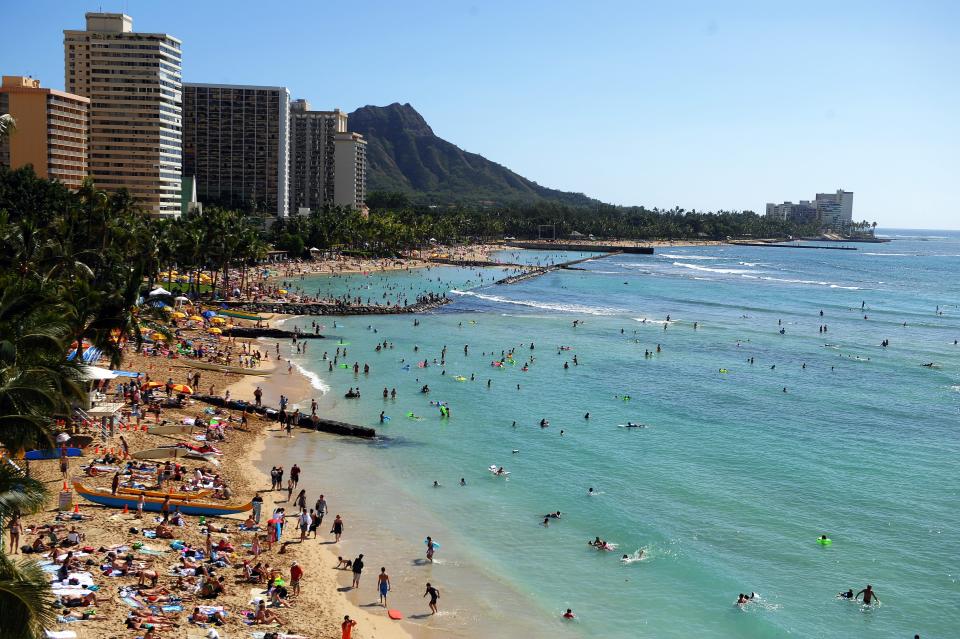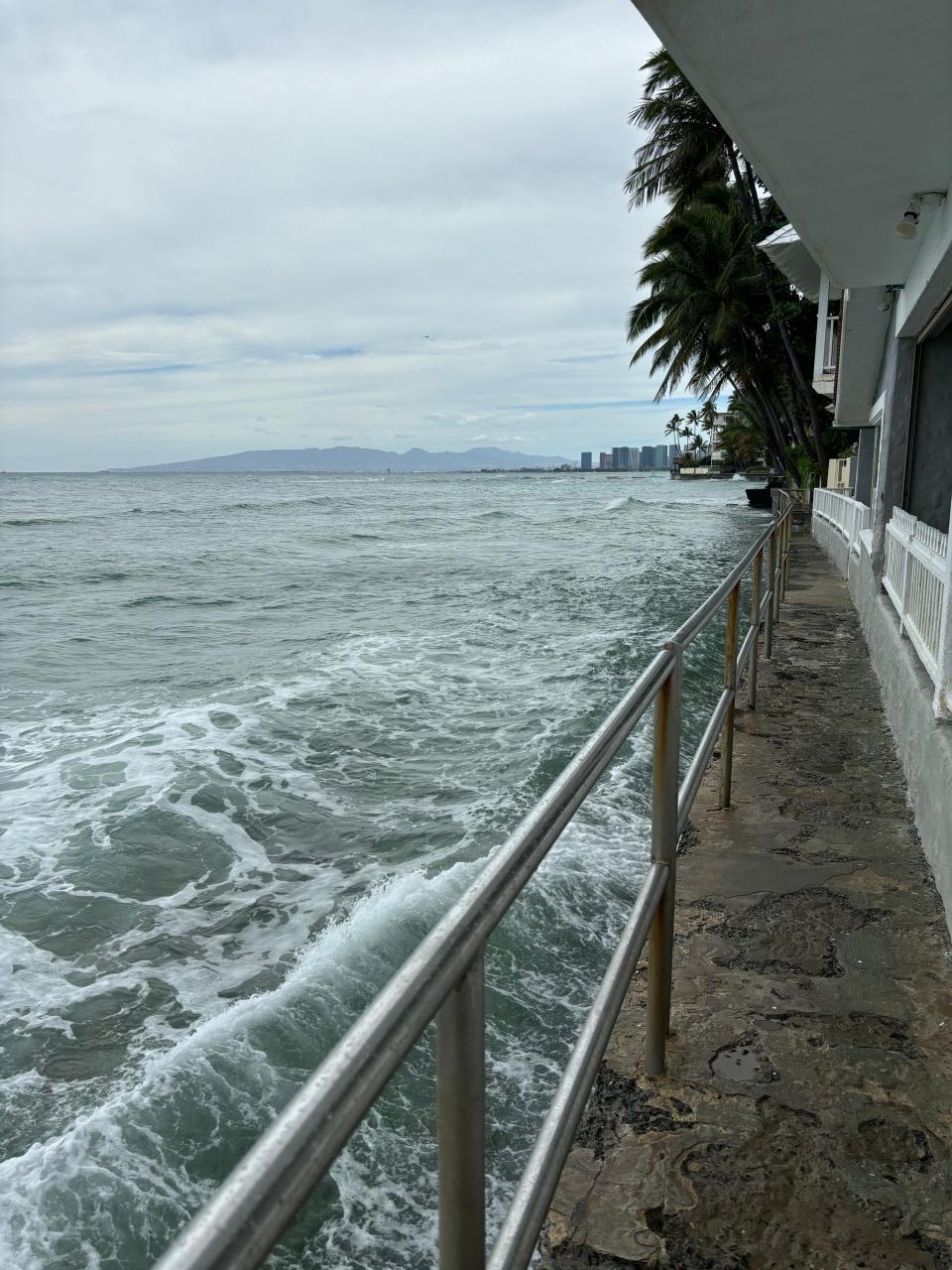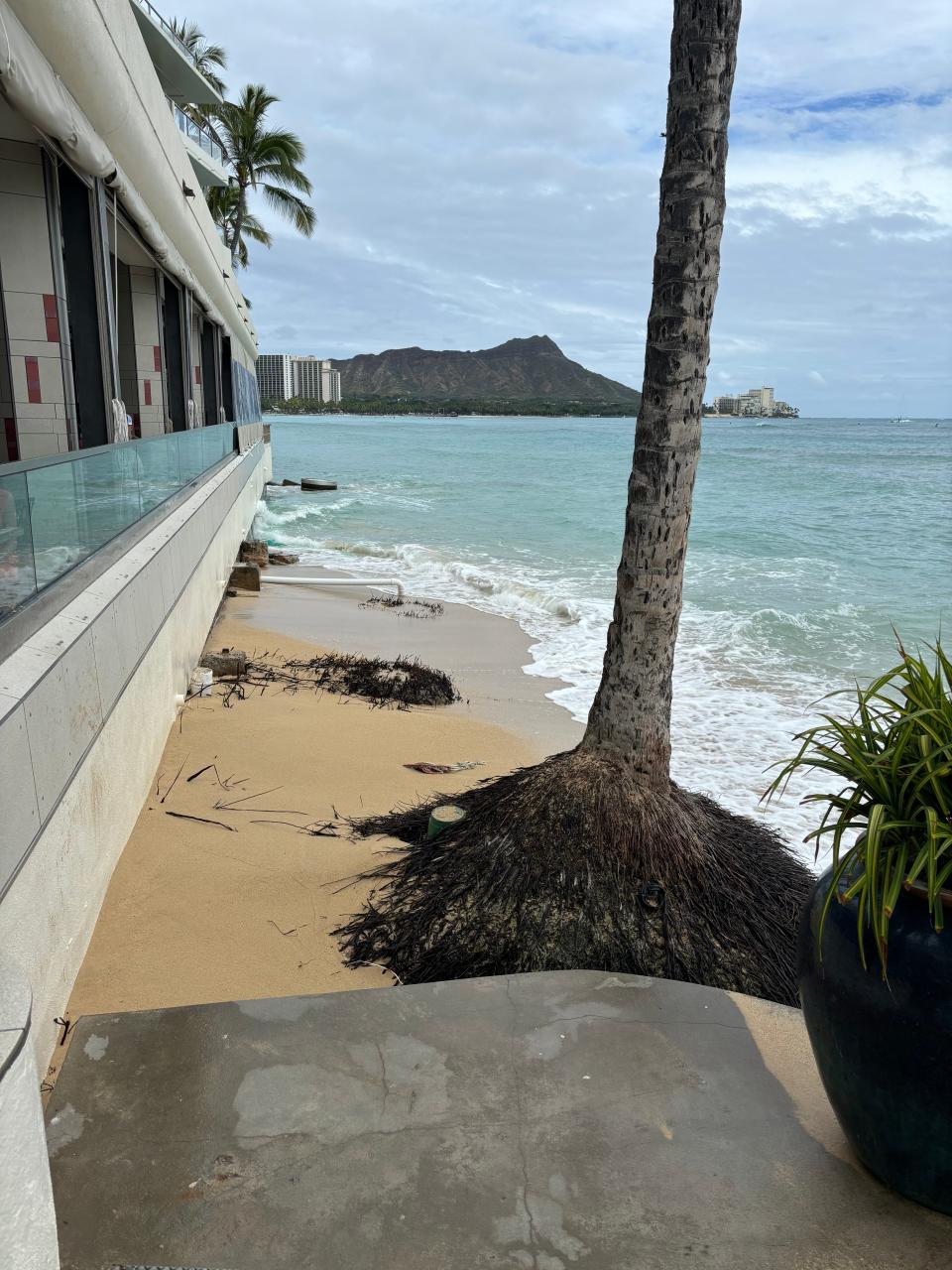Hawaii's beaches are disappearing: The uncertain future of Oahu's iconic Waikiki
Climate change is drastically impacting the world around us, including the way people travel and the destinations themselves. “Green Travel” is a seven-part series delving into how climate change is transforming the landscape of travel.
OAHU, Hawaii — Hawaii’s most famous coastline, Waikiki Beach, is not going to be the same in the next 50 years.
Oahu is the most visited Hawaiian island, with its iconic Waikiki neighborhood serving as a central base for many travelers, but it has already been changing. The beaches flanking Waikiki have narrowed, and in some areas, are nonexistent. During high tide or if there’s a swell, waves crash onto walkways, soaking passersby.
These issues didn’t exist decades ago, at least not as noticeably as they’ve become today. And it’s only expected to get worse.
In as little as 20 years, roads, condos and resorts located just a few blocks from the water could be flooded as groundwater continues to rise. In the future, storm drains could fill up – imagine a bathtub running over – and the beaches could continue to disappear. Waikiki was actually built on top of water, a wetland that was drained then filled for development, although you’d never think so looking at the high-rises and concrete today.
Get more news like this delivered to your inbox by signing up for our Travel newsletter here.

“That’s a huge problem in Waikiki and it’s probably ground zero for this problem,” said Charles Fletcher, the Interim Dean of the School of Ocean and Earth Science and Technology at the University of Hawaii at Manoa and one of the leading climate scientists in the state.
It’s not just rising waters and stronger swells from the makai (ocean) side, but heavy rainfall and flooding from the mauka, or mountain side that threaten Waikiki, which has the highest density of hotels in the state and accounts for $7.8 billion in visitor dollars.
Confronted by climate change, Waikiki and the broader Hawaiian islands are rethinking their future to ensure survival, including an adaptation plan for the tourist hub. Recognizing the high stakes – such as the fact that tourism accounts for a quarter of the economy – both private and public sectors are collaborating to build Hawaii's resilience for future generations.
“Beaches are a big part of the tourism experience and with sea level rise – and this applies to every coastline in the world – Hawaii is facing some serious challenges in getting out of the way of the migrating shoreline,” said Fletcher. “So far, we are having a hard time winning the battle of preserving beaches against a rising ocean.”
Pacific islands, including Hawaii, are especially vulnerable to the impacts of climate change, such as intense storms, wildfires, and coral reef bleaching, due to their remote oceanic locations. Swift action is being taken to address these challenges.
What’s happening to Hawaii’s beaches?

Hawaii's beaches are disappearing, with about 13 of the state's 750 miles of coastline gone, according to the 2022 Annual Report by the Climate Resilience Collaborative, which is funded by the Office of Naval Research and partners with researchers at University of Hawaii at Manoa. Seventy percent of Hawaii's beaches are chronically eroding. One big reason for that is rising sea levels.
“It’s extremely urgent, it's an impact today, it’s not a tomorrow issue,” said Matthew Gonser, Chief Resilience Officer at the Office of Climate Change, Sustainability and Resiliency, which was established through a city charter amendment approved by public vote in 2016.
Alongside rising sea levels, coastal erosion on Oahu is exacerbated by a common beach management practice. As seen on the ends of Waikiki, the ocean has swallowed up the beach. No sand, just water crashing into the seawall.
These types of barriers are known as shoreline hardening, a manmade way to prevent the ocean from flooding land and development behind it. Unfortunately, this has caused more harm than good.
Nearly one-third of Oahu’s beaches are hardened, according to a 2020 study by the Climate Resilience Collaborative. Using computer models, the researchers predicted that by 2050, nearly 40% of the island’s beaches could be lost.
“Sea level has been rising over the last century, and it’s projected to continue to rise and actually rise faster than it has been, so what that means is most of our beaches are wanting to migrate inland,” said Kammie Tavares, a graduate researcher who led the study.
In the past century, sea levels in Hawaii have risen over six inches, according to the City and County of Honolulu Climate Change Commission.
The loss of beaches carries more than just the economic implications of tourism. Natural systems depend on the beach like sea turtles that nest and endangered Hawaiian monk seal that raise their pups along the sand. The beach is part of a crucial marine life cycle, so its disappearance will impact the livelihoods of fishermen. There’s also a cultural loss as many Hawaiian ancestral bones have been buried in the beaches and risk being exposed.
“Then of course, there’s also us,” Tavares said. “When we lose beaches, we lose our connection to our spaces.”
However, the main strip of Waikiki Beach, situated in front of the iconic pink Royal Hawaiian Hotel, is a different story: it’s a completely man-made beach. Historically, sand is vacuumed from offshore to resupply sand on the beach. Most recently, this was done in 2021 with 21,700 cubic yards of sand, but will likely happen every five to 10 years in the future as the shoreline erodes faster. Groins and break walls have been built into the water to protect the sand from the water.
“Prior to that, we hadn’t put sand there for 20, 25 years,” said Dolan Eversole, a coastal geologist and the Waikiki Beach Management Coordinator for the Hawaii Sea Grant Program. “(Now it is like) whoa, we have to do something here because it’s getting really bad.”
What’s next for Oahu’s beaches?
It will take four feet of sea level rise to drown nearly half of Waikiki, and researchers plan on one foot of sea level rise by 2050 and four to six feet by 2100. “One foot, we can adapt, but four to six can be catastrophic,” said Eversole. “It’s not going to be pretty.”
This isn’t news to government officials. For the past decade, scientists and officials have had their eye on Waikiki’s fate, Fletcher said. The state is pushing for regenerative tourism, where travelers help steward the islands and natural resources are properly managed and protected.
Currently, the Office of Climate Change, Sustainability and Resiliency has sensors in different storm drains throughout Honolulu to evaluate if water is coming back up. In partnership with the Board of Water Supply and other public agencies, monitors will be placed underneath Waikiki to track if water is getting closer to the surface.
Several projects are underway, including constructing a groin along a section of Waikiki Beach in front of the Halekulani Hotel and the OUTRIGGER Reef Waikiki Beach Resort, which has nearly eroded. The plan involves replenishing the beach with sand, and the groin will protect this sand from the waves.

Before Oahu communities face the daunting and contentious task of migrating inland, the primary focus is on adaptation. The Office of Climate Change, Sustainability and Resiliency also engages with the community, having met with neighborhood boards in 2016 to get their input.
“In a place like Waikiki, it’s so important and most people agree, we’re going to have to adapt,” Eversole said.
Eversole serves as an advisor for the Waikiki Special Improvement District Association, which was created in 2015 to focus on the area’s resiliency and made up of stakeholders such as property owners to government officials and hotels themselves. The organization is working on an adaptation plan for the neighborhood and is in the visioning stage.
Some ideas being floated include raising Waikiki’s streets into walkways to allow water to run under or more canals (right now, there’s just the Ala Wai Canal running along the mountain-side of Waikiki). Another is to build a boardwalk.
“We need to be, in my opinion, innovative and creative in how we picture adaptation in Waikiki and what’s possible,” Eversole said.
Currently, $800,000 in state funding is appropriated for the Waikiki Adaptation Plan. Although significant work remains, the future holds strong potential. “I’m confident and the reason why, working with government officials right now, there’s a wild acceptance we need to do something,” he said.
Some researchers are also finding value in going back in time to Native Hawaiian stewardship practices. After all, these people took care and lived off the land for centuries before heavy development. Centuries-old indigenous knowledge and history can help better inform scientists and current resource management systems.
“Resiliency is a big push for us,” said Fletcher. “It doesn’t exist yet, but we are working to create it.”
This article originally appeared on USA TODAY: Hawaii could lose 40% of its beaches by 2050. What happens now?

